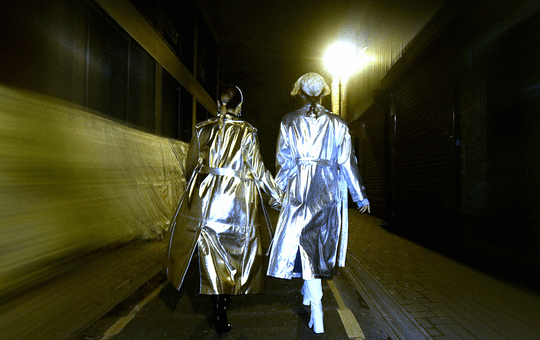Comment: Why 'Teen Mom' Farrah Abraham's dream is our reality
If you’d asked me a couple of weeks ago what one of the most controversial, challenging records of 2012 would be, a download-only soundtrack to the standard ‘tell-all’ by a minor US celebrity and reality TV star certainly wouldn’t have been one of them. I’d have gone with Laurel Halo’s ear-bashing Quarantine or Maria Minerva’s music-making from a meta-perspective, Will Happiness Find Me?, rather than Farrah Abraham’s My Teenage Dream Ended. But here we are, discussing the merits of a work by a 21-year-old sous chef and online entrepreneur with a backlog of coverage on MTV’s 16 and Pregnant, plus a spin-off.
It’s enough to behold the YouTube video of ‘On My Own’ (above) to be mystified. Shaky home-footage of a disembodied hand pushing a toddler on a swing, a dizzying shot of the sky, a woman and child skipping along a concrete path. That’s the all-too-literal interpretation of the wobbly, auto-tuned-to-the-point-of-being-indecipherable vocal and its equally guileless analogies of “I’m swinging up little one’s hand/ I’m the push behind the swing”. Beneath it travels a lurid monophonic synth line and a repetitive beat that carries on until stopping short, abruptly ending the track. And, like the video of Abraham’s daughter Sofia frolicking through a field that turns out to be a graveyard, it’s just plain bizarre. The rest of the album – mapping a disjointed chapter-by-chapter rendition of a tragic story across death, drug abuse and depression –offers few dynamic shifts, no hooks and nary a sustained rhythm. Whenever you think you’ve found one, like in the rave closer ‘Finally Getting Up From Rock Bottom’, the cadence falters and leaves one transfixed and dumbfounded. A build-up in ‘Caught in the Act’ slips quietly away, replaced by the churning tide of stock electronic samples; unease in the wake of wonky pitch and tempo shifts resembling a poorly connected, slightly funny, Skype conversation.
Ridiculed by mainstream press and mostly ignored by alternative media, there are all the questions of branding, promotion and prejudice here to explore. But what makes My Teenage Dream Ended so significant is its realistic portrayal of a mind mashed by mass media. The title’s quietly clever inversion of the Katy Perry album Teenage Dream is offset by crude idioms like Liar Liar (“your pants on fire”), absurd motifs like a camera-clicking sound byte on the hysterical eurodance of ‘After Prom’ or a Hawaiian Aloha fade-out following the obscenely short wig-out of ‘The Sunshine State’. It’s a silly sense of humour many contemporary fringe artists are known to indulge in. If it isn’t Maria Minerva’s looped sample of The Chordettes’ ‘Mister Sandman in The Star’ on Will Happiness Find Me?, then it’s Laurel Halo’s intentionally discordant vocal tracking over all of Quarantine. In fact, the digital world is rife with self-aware artists indulging in cheeky tributes to trash, where Lauren Devine’s ‘Just A Little Ready’ (which, incidentally, lists Laurel Halo in the writing credits) is somehow distinct from the clueless posturing of Rebecca Black’s ‘Friday’. But as Susan Sontag writes, “the pure examples of camp are unintentional; they are dead serious”, and in that, the aforementioned artists pale in comparison to Farrah Abraham. Because what’s more pertinent about My Teenage Dream Ended is not whether it qualifies as pop music or outsider art, but where it falls within the realms of a camp aesthetic and what that means for achieving a greater understanding of the world around us.
That’s because My Teenage Dream Ended is a frightening, fragmented portrait of modern life from the perspective of Generation Z; a Warholian nightmare of people raised on digital culture who see little to no distinction between the virtual and the ‘real’ worlds. It’s a place where life is a wasteland of half finished projects, unformed ideas and an audio interface strewn with the sound bytes and debris of anything that takes one’s fancy. It’s oddly reminiscent of video artist Ryan Trecartin’s weird suburban nightmares, where non-sequiturs and worn out clichés –both sonic and literal – are thrown together into a non-linear audio-visual narrative, generating a glut of information, confusion and an overwhelming sense of isolation. You only have to look at the cross-thinking exploits surrounding the neglected ‘Steven’ in I-BE AREA (Adoption Audition Tapes and Head-PArent) – “I feel like I’m just a household prop, with a really awesome rockin’ bedroom, okay?” – to make the comparisons to something like My Teenage Dream Ended. Except that, where Trecartin offers a mere rendering of modern life from the perspective of an 80s baby onlooker with an analogue way of thinking, 90s-born Farrah Abraham holds up a mirror and reveals the digital dystopia from whence she came, in her very own shattered reflection.
When you think about it, there’s really no argument for disregarding ‘My Teenage Dream Ended’ beyond some eyebrow-raising preconceptions about what constitutes pop and/or avant-garde music. And if this millennium has taught us anything, it’s that those guidelines for contextualizing and determining an artwork’s cultural value are arbitrary at best. Britney Spears’ Blackout, Christina Aguilera’s Bionic, hell, even Robbie Williams’ hip hop flop Rudebox were records met with an ambivalent reception by its intended audience, only to be appreciated for just how significant they were the further we move away from them. After all, it’s time that “liberates the work of art from moral relevance” and as Katy Perry and Lady Gaga’s all-too-conscious-Camp is reduced to mere symbolism, it’s naïve artists like Farrah Abraham that present a truly thought-provoking challenge to the status quo. That’s because it doesn’t take vanilla songs and au courant social engagement to make a record of the future but the unconscious mindfuck of pure, unfiltered self-expression to create the subversive masterpiece of today, and chart-topper of tomorrow.













